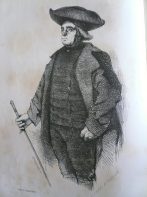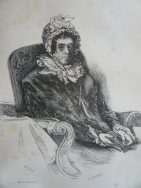
Ursule Mirouët
THE HUMAN COMEDY – Honoré de Balzac Fifth volume of works of Honoré de Balzac edited by widow André Houssiaux, publisher, Hebert and Co, successors, 7 rue Perronet – Paris (1877)
Scenes from provincial life 
URSULE MIROUËT – published in 1841
Analysis of the 0euvre As with Scenes from Private Life, this series comprises four volumes in the general division of 19th-century studies of manners. These four volumes were published between 1834 and 1837. They contain Balzac’s most typical and famous novels – while the Scènes de la vie privée begun by Balzac in his early days in 1830 are sometimes a little disparate, the Scenes from provincial life , launched four years later, are much more useful – they are defined by four criteria: First of all, they are opposed to the Scenes from private life, because the latter point out the pitfalls to which youth is exposed by the vivacity of its infatuations, while the Scenes from provincial life show the calculations of mature age. Then they describe an environment in which the social organism, leading a vegetative life, accumulates material and moral forces, restorative forces whose dissipation the Scènes de la vie parisienne will show. Secondly, unlike the hectic destinies depicted in Scenes from Private Life or Scenes from Parisian Life, the provinces offer a picture of motionless, seemingly uneventful existences, in which ambitions were secret, maneuvers concealed. These are small facts that alone attest to passions that are simmering in silence. To make these secret movements felt, the novelist has to convey the importance of seemingly minute details, which in reality betray serious disorders or suffering.

Chaperon

Goupil
The story Ursule Mirouët doesn’t belong to any of the categories represented either by the “rise” of provincials to the capital or, on the contrary, the raids of Parisians on the provinces. It’s a story set in the small town of Nemours, where a philosophical old doctor has come to rest in his old age. He’s very rich, he’s very learned, he’s a member of the Institut. Nemours is his childhood home. His fortune is being watched by his many relatives, who are already calculating how they will divide his inheritance. Much to the chagrin of his heirs, he has taken in and adopted an orphan girl, who is his lonely, fragile, defenseless ward. The originality of this plot lies in its depiction of the social fabric of Nemours, with unscrupulous heirs plotting to disinherit Ursule and take over all the doctor’s possessions. Family alliances (marriages between cousins from the Nemours petty bourgeoisie) resulted in the following heirs to the good doctor: the Crèmière family, who monopolized the mills; the Minorets, who ran the tanneries; the Massins, who worked in commerce; the Levraults, who ran the farms; the Minoret-Levraults; the Levrault-Minorets). These families are further reinforced by parents or children with legal responsibilities and other functions, forming a tightly woven social network in the province. This local dictatorship, exercised by a kinship that occupies all the channels through which social life passes, and in particular the management and transmission of fortunes, is woven in this plot around notaries, lawyers, the clerk of the justice of the peace, property dealers, the postmaster and the gendarmerie officer, all of whom are heirs to Dr. Minoret (see names above) and who, by virtue of their position, will control his every move. These “hidden crimes”, which often escape the law, are the cause of many wills being destroyed. Here’s where the action begins: on the doctor’s death, one of his heirs, the postmaster, steals the doctor’s will, in which his ward Ursule was designated as his universal legatee. Disinherited, Ursule took refuge with her nanny in a small, unpretentious house, which she simply furnished with taste and which she knew how to make pleasant. Despite her poverty, this beautiful and admirable girl’s qualities will continue to arouse the jealousy of her heirs. Faced with their persecution and the schemes inspired by the culprit and his accomplice (the postmaster and Goupil), Ursule receives anonymous letters. Harassed by slander and blackmail, the young girl wasted away. Innocence will triumph in the end. Supported by Savinien’s love and the doctor’s friends. Aided by premonitory dreams and the suspicions aroused by Minoret-Levrault’s culpable attitude – when, for no apparent reason, he tries to redeem his misconduct by offering Ursule large sums of money – Ursule will eventually regain her rights and find the happiness she deserves. She married Savinien, who had a successful career in the navy and lived happily in his château in Le Rouvre.

Madame de Portenduère
Paris, June-July 1841
The characters Valentin Mirouët: Harpsichordist and instrument maker, died in 1815, from whom a legitimate daughter Ursule, wife of Denis Minoret, from whom two children died in infancy: a natural son, Joseph, born of an extramarital affair who died in 1814, leaving a daughter, Ursule, born in 1814, adopted by her uncle Minoret. Dr. Denis Minoret: Wealthy physician, philosopher and scholar, husband of Ursule, daughter of Valentin Mirouët, who died in 1793. Joseph Mirouët: The natural son of Valentin Mirouët, Joseph fled with a young girl to Germany. He ended up marrying a girl from Hamburg, and ruined by his reckless lifestyle, returned to France where his wife died in childbirth, leaving a little Ursule. He won’t survive the loss of his wife. The good doctor adopted little Ursule, who became his ward. Ursule Mirouët: Doctor Denis Minoret’s niece. Orphaned, she is adopted by the good doctor. She married Savinien de Portenduère. La Bougival: Antoinette Patris, Ursule’s nanny and widow of Pierre (no surname), is known as “La Bougival”. Goupil : First clerk to Mr Crémière-Dionis, Nemours notary – Notorious scoundrel Mme de Portenduère: Savinien’s mother, a member of the upper nobility, whose values and morality stem from her origins make her a woman opposed to her son’s alliance with Ursule, the daughter of a bourgeois. Savinien de Portenduère: Son of Mme de Portenduère – an unfortunate nobleman who became rich in the navy. Le curé Chaperon: the parish priest of Nemours – friend of the doctor and Ursule. Minoret-Levrault: the postmaster and purveyor of Ursule’s will. Zélie Levrault: The postmaster’s wife, with a fierce jealousy and hatred of Ursule. Désiré Minoret-Levrault: Son of Zélie and the postmaster, law student – spoiled brat and tyrant of Nemours. Monsieur de Jordy: Captain, former military school teacher – friend of the doctor and Ursule. Monsieur Bongrand: Justice of the peace in Nemours and friend of the doctor and Ursule. Monsieur Massin: Clerk – owner of his own clerk’s office. Madame Massin: cousin of Minoret-Levrault, the postmaster. Monsieur Crémière: Nemours tax collector. Madame Crémière: Wife of the tax collector, vain, greedy and waiting for her uncle’s inheritance to decorate her salon and make her the equal of the notary, Madame Crémière-Dionis, whom she admires and envies. Massin-Levrault junior: Clerk of the Justice of the Peace. M. Crémière-Dionis: Notary in Nemours – Massin’s partner in buying up the property of indebted farmers. The Marquis du Rouvre: An indebted nobleman who is forced to sell his property to the postmaster – which eventually reverts to Ursule. The doctor’s collateral heirs: Minoret-Levrault and his wife, Mr and Mrs Massin-Levrault-junior, Mr and Mrs Crémière-Crémière.
1) Source analysis/history: Preface compiled from the complete works of the Comédie Humaine (Volume VII) published by France Loisirs 1985 under the auspices of the Société des Amis d’Honoré de Balzac.
2) Part of the characters’ genealogy is inspired by Félicien Marceau’s “Balzac et son monde” (Balzac and his world), Gallimard.
No Comments